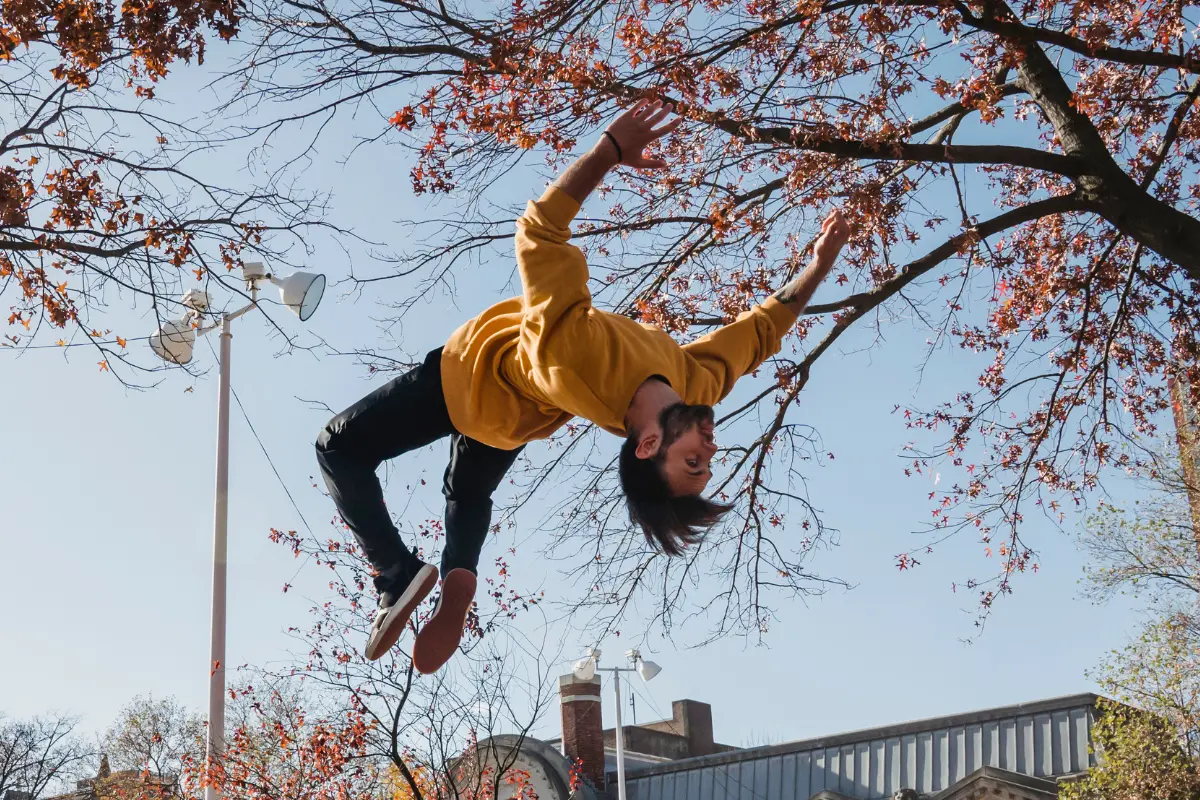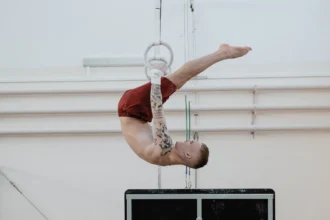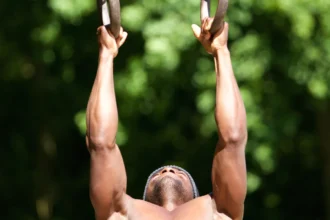In gymnastics, front flips and backflips stand out as two of the most impressive maneuvers. A front flip, also known as a front tuck, involves leaping into the air and rotating forward, while a backflip (or back tuck) requires jumping upwards and spinning backward.
But which one is harder? Let’s take a closer look at both gymnastics moves to figure out which one is typically easier for beginners to master.
The Technical Demands
Frontflip: A Technically Complex Move
Many gymnastics coaches and experts agree that the frontflip is often more technically demanding compared to the backflip. Here’s why:
Forward Momentum:
- The frontflip requires generating forward momentum while rotating in the air. This is a more complex movement compared to the backflip, where the focus is primarily on upward and backward rotation. Athletes need to push forward with enough force to start the rotation, while also jumping high enough to complete the flip.
Tight Tuck and Timing:
- Once airborne, the gymnast must quickly tuck their knees toward their chest to accelerate the rotation. This has to be done with the right amount of force and timing to avoid under-rotating, which could result in a rough or awkward landing. The tuck must also be released at just the right moment, giving enough space to open up and spot the landing. Opening too early or too late can lead to overshooting or under-rotating.
Spotting the Landing:
- One of the toughest parts of a frontflip is the inability to spot the landing until the very end of the rotation. Since you’re rotating forward, you can’t see the ground until almost the end of the flip. This lack of visual feedback makes it harder to judge the landing distance, a crucial factor for landing safely.
For beginners, mastering the frontflip requires strength, timing, and a lot of practice to perfect the tuck and landing technique.
Backflip: Simpler Physical Mechanics, But Mental Challenge
The backflip, while still challenging, is often considered physically simpler because it relies on the body’s natural ability to rotate backward. Here’s why:
Vertical Jump and Rotation:
- The backflip starts with a strong vertical jump, followed by a backward rotation. Unlike the frontflip, which requires you to rotate both forward and upward, the backflip focuses mainly on height and backward rotation. Once in the air, you pull your knees into a tuck to accelerate the flip, and as you approach the end of the rotation, you need to open up to land.
Spotting the Landing:
- A big advantage of the backflip is that you can spot the landing during the rotation. Since you rotate backward, you begin to see the ground as you flip, giving you more control and better judgment for the landing. This visual feedback is crucial for many athletes and can make the landing feel more controlled compared to the frontflip.
Despite these physical advantages, the backflip comes with its own set of challenges, particularly when it comes to mental readiness.
The Psychological Aspect
While the frontflip may be more technically complex, the backflip often presents a bigger psychological challenge for many athletes, especially when they first attempt it.
Backflip: Overcoming the Fear of Rotating Backward
For most beginners, the thought of rotating backward is intimidating. Unlike the frontflip, where you rotate forward (which feels more natural), the backflip forces you to rotate blindly, which can feel like you’re falling backward without knowing where you’ll land. This creates a significant mental barrier.
Fear of Falling:
- The major mental challenge with the backflip is the fear of falling onto your neck or back. Since you can’t see the ground while rotating, it’s harder to gauge how much rotation you need to complete the flip. Many beginners worry about misjudging the flip and landing poorly, which makes it feel riskier.
Commitment to the Move:
- Unlike the frontflip, where you can more easily control the forward rotation, committing to a backflip can feel like a leap of faith. You need to push yourself into the flip without knowing where you’re going, which can be unnerving for beginners.
However, once you build confidence and trust your body’s ability to rotate backward, many people find that backflips become easier with practice.
Tip: How To Get Over A Fear Of Backflips
One of the best ways to ease into a backflip is by practicing on a trampoline. The softer surface and bounce make it less risky and more forgiving.
1) Try Back Drops and Pullovers A great exercise to get started is the “back drop.” This involves flipping backward and landing on your back. It helps you feel what it’s like to go over without the fear of landing directly on your head. Once you’re comfortable with that, you can try a pullover, where you roll over and land on your feet.
2) Use Your Hands for Support: If you’re still nervous, you can start doing a back handspring first. This move allows you to use your hands for support as you flip. As you get more comfortable, gradually try doing the move without using your hands. This helps you get used to flipping backward with more control and confidence.
3) Work with a Spotter: Having someone there to spot you can make a huge difference. A spotter is someone who stands beside you, helping you flip safely and making sure you don’t land on your head. They’ll push you gently to guide your flip and ensure that you rotate properly.
4) Practice on Soft Surfaces: When you’re learning to do a backflip, it’s important to practice on a soft surface to reduce the risk of injury. Trampolines are great, but when you move to the ground, choose softer areas like sand, grass, or gym mats. Avoid practicing on hard surfaces like concrete at first.
5) Gradually Move to the Ground: Once you’re comfortable with the trampoline, you can start practicing the backflip on the ground. But don’t rush into it! Start by practicing the same technique—going over to the side with your hands—and gradually build up to flipping over.
Frontflip: Less Intimidating, but Still Challenging
On the other hand, the frontflip may seem less intimidating psychologically because it involves rotating forward—a direction that feels more natural for most people. Most athletes are more comfortable with moving forward (e.g., jumping or diving), making the concept of rotating forward feel less risky.
- Visual Feedback:
While the frontflip doesn’t offer as much feedback during the rotation (until near the end), many athletes find it easier to commit once they’re familiar with the movement. The fear of rotating into the unknown, like with the backflip, is less of a concern.
However, despite this advantage, the lack of visual feedback during the flip can still confuse when trying to judge the landing. This is especially true when you first attempt a frontflip and lack the experience to time the rotation and spot the landing properly.
The Role of Sport and Discipline
The difficulty of mastering the frontflip or backflip also depends on the sport.
Gymnastics and Tumbling
In gymnastics, the frontflip is often introduced first, especially for beginners or younger athletes. Coaches typically use progression drills to help students learn how to rotate forward, tuck tightly, and land safely. The forward momentum of the frontflip makes it feel more intuitive, and many gymnasts build the skills necessary for other tricks around it.
Parkour and Trampoline
In parkour or trampoline, the backflip is often seen as more accessible once athletes gain enough air time and confidence. Though the initial fear of rotating backward may be stronger, the backflip’s physical mechanics feel more natural once athletes are familiar with aerial movement. The ability to spot the landing and the simplicity of upward rotation make the backflip easier to perform once you’ve gained confidence.
Snowboarding and Other Action Sports
In snowboarding and other action sports, athletes often find that the backflip becomes easier with practice. The time spent in the air gives you more time to rotate, and the commitment to rotation feels more fluid as you get comfortable with the movement. While the fear factor may seem higher initially, many snowboarding athletes find that the backflip becomes second nature with practice and the right technique.
Backflip Or Frontflip Easier: Which Is Harder?
For most beginners, the frontflip may be easier to start with since it feels more natural, but the backflip might eventually become easier once the fear factor is overcome—especially in disciplines like parkour and snowboarding, where airtime helps with the motion.
No matter which flip you choose to start with, both the frontflip and backflip provide valuable lessons in body control, strength, and overcoming mental barriers. It’s all about where you feel most comfortable and which movement aligns best with your natural abilities.






